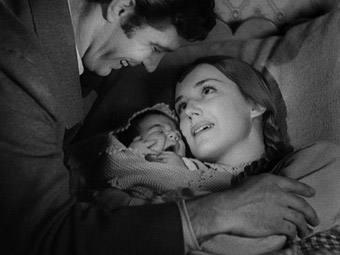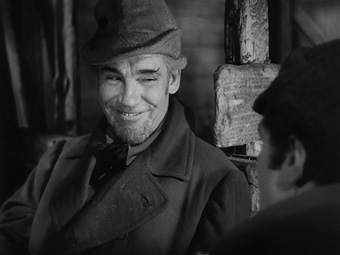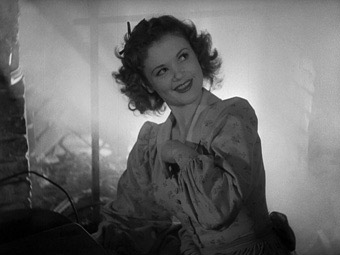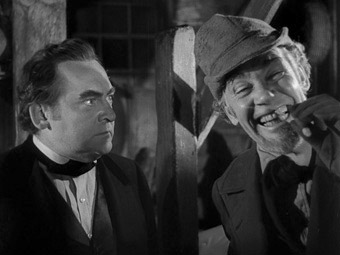|
In these days of two-minute movie pitches, it's interesting to ponder how The Devil and Daniel Webster might have been sold to studio execs back in the 40s. It's a reworking of Faust, you see, set in 19th Century New Hampshire and with a strong moral message, but it's also funny and smart and sexy. Actually, this is starting to sound rather attractive. The only blip in there for a film made in 1941 is that last one. Getting even faintly erotic in Production Code era American cinema was a bit of a no-no, but clearly no-one told director William Dieterle, so he went and did it anyway. And if you're expecting a qualifier along the lines of "well it would have been considered erotic back then but it won't work for a modern audience" then think again. The Devil and Daniel Webster may keep its flesh well and truly under wraps, but I can pretty much guarantee that there's one character here that will have the eyes of most of the male audience bulging. And setting the film in the past proves no barrier to character engagement, providing a more God-fearing setting for the film's moral message and giving the leading man free range to liberally use curse words that will not cause offence to a 1940s audience, con sarn it.

Our agitated central character is Jabez Stone, a poor New Hampshire farmer who, in common with his neighbours, is in serious hock to local moneylender Miser Stevens. As Jabez prepares for church on one particular Sunday, luck really isn't on his side – his piglet breaks a leg, a fox gets into the hen house, his wife Mary is injured in a fall, and a sack of grain he was going to offer Stevens in place of payment rips and spills its contents into a puddle. "That's enough to make a man sell his soul to the Devil!" he angrily proclaims, "And I would for about two cents!" Enter the smiling figure of Mr. Scratch, who offers to provide Jabez with seven years good luck, which he kicks off with the discovery of a bounty of gold coins buried under the very barn they are standing in. All Jabez has to give in exchange is his soul. Desperate though he is, the young farmer hesitates, but Scratch brushes it off. "Why should that worry you?" he tells him. "The soul's nothing. Can you see it, smell it, touch it? No. This soul, your soul, a nothing, against seven years good luck. You'll have money and all that money can buy." Oh he's very persuasive and Jabez is only too keen to believe him. The contract is signed and Scratch is as good as his word. Jabez pays off his debts and his farm goes into profit. When a hailstorm decimates the crops of his neighbours, those grown by Jabez are left untouched. In just a few short years he has raised a son and made enough money to build himself a handsome mansion.
So all is well with the family Stone then. Well, not quite. In his journey to wealth, Jabez effectively shuns his neighbours and former friends and is soon regarded with suspicion and distrust by them all. On top of that, his vocal uncertainty about the contract prompts Scratch to send along an old friend to keep an eye on him. The friend in question is Belle, a walking symbol of sexual corruption who takes the place of the previous maid of the house and in no time at all has usurped Mary's position as both Jabez's companion of choice and little Daniel's mother. But hovering on the sidelines is Daniel Webster, an honest and sincere politician with eyes on the presidency, who has been fighting for the rights of farmers and has repeatedly rejected Scratch's attempts to corrupt him. "I'd rather see you on the side of the opposition" Webster tells him when they meet again in Jabez's village. "Oh, I'll be there too," Scratch cheerfully assures him. Webster makes enough of an impression on the Stone family for Jabez to rise in his defence when he falls asleep instead of delivering a requested speech (want to guess who arranged that?) and for Mary to request he become godfather to their child. Later, when things turn bad for Jabez, it's Webster who comes to his aid to do legal battle with Scratch for the ownership of Jabez's soul.
OK, let's get one thing sorted before we proceed – as an adaptation of Faust, The Devil and Daniel Webster tells a moral tale from a partially religious viewpoint, where God is good and the Devil is out there just waiting to pounce on the non-devout. But this is really surface dressing for a morality tale whose real focus is the importance of personal integrity and corrupting power of greed, a message that's as relevant now as it ever was. And while F.W. Murnau's 1926 version may forever remain the most technically arresting and visually imaginative realisation of the Faust story, rarely, if ever, will you see it told in a more entertaining manner than it is here.

Much of this is down to some absolutely spot-on casting and performances. James Craig steers a careful path around any hint of parody as the good-hearted country hick who is corrupted by money, Anne Shirley stops comfortably short of overdoing Mary's wide-eyed sweetness and impossible tolerance, and Jane Darwell revives her sturdy matriarch from The Grapes of Wrath to convincingly see through any trace of demonic tomfoolery. As Daniel Webster, Edward Arnold projects the necessary blend of warm approachability, down-to-earth pragmatism and incorruptible authority required to sell him as the real deal and to convince even the Jury of the Damned that his final speech – which sails perilously close to patriotic cornball – comes from the heart rather than a spin-doctor's pen. But if the Devil has the best tunes then he's also secured the most sublime casting. As Scratch, Walter Huston's every appearance is an absolute joy, transforming the Devil into a perpetually jocular ball of slithery corruptive persuasion, a wily con-man who pops up from nowhere to tempt the unwary with soft-spoken promises and a Cheshire Cat grin. He's a genuinely glorious screen creation and a real gamble on the filmmakers' part, given that he's considerably more fun than his morally upright opponent – were he the product of more recent cinema then a sizeable cult following and a McFarlane action figure would be pretty much guaranteed. But a good part of what makes Scratch so memorable goes doubly so for Belle. OK, a home run is scored from the start in the casting of strikingly attractive French actress Simone Simon, but everything about her first appearance in the film is designed to provide the males in the audience (and a good few females, I'd wager) with a most convincing reason to sign away their soul and plunge headlong into the dark side. I've got the blood and the quill all ready.
So why is it exactly that we continue to root for Jabez's redemption in the face of such inviting temptation? After all, given the choice between pious Mary or sexpot Belle, only the sternly chaste would seriously opt for the former, and when mother and Mary are listening to a deadly dull sermon at the local church, who wouldn't rather be back at home playing cards with Jab and his mates? Well, as with all great dramas, it's as much to do with what bristles beneath the surface as what sits on top. While the story plays with religious conceptions of right and wrong, at the heart of the film is a more universal tale of fairness, decency and solidarity. Dieterle himself was a fervent anti-fascist and there's a clearly detectable socialist subtext at work here, one that sides with the struggling farmers and that regards their formation of a grange union as a positive way forward. Jabez, meanwhile, is corrupted not by temptations of the flesh but by the lure of capitalism – his road to riches is one common to many an American entrepreneur, and with the accumulation of wealth comes increasing disregard for the plight of his fellow man. Scratch himself even questions America's own moral stance in an eloquent speech in which he outlines his own involvement in the nation's birth and evolution, and when Webster questions the make-up of his Jury of the Damned, Scratch is quick to point out that they are "Americans all." The leftist stance is further reflected in opening credits that do not specify specific film roles, giving all who "collaborated on this picture" equal billing in the manner of a worker's cooperative. A degree of strategic balance is nonetheless provided by making Webster himself a humanitarian Republican, something staunch Democrats will doubtless regard as oxymoronic.

The script, by Dan Totheroh and Stephen Vincent Benét from Benét's short story, is an absolute belter, moving the plot forward at the pace of a galloping horse and peppering every conversation with memorable dialogue, skating confidently close to outright parody in Webster's righteous patriotism, with his intention to fight for Jabez's soul announced by the proclamation that "I'd fight ten thousand devils to save one New Hampshire man!" And despite the joy of Huston's delivery, it's Webster who delivers my favourite line of the film. As he prepares to do legal battle with Scratch, he takes a swig of rum and gently admonishes the distraught Jabez for declining to do likewise: "Oh come, come now. Just because you've sold your soul to the Devil, that needn't make you a teetotaller."
Director William Dieterle's mastery of expressionistic lighting, telling angles and editing – so thrillingly demonstrated in his 1939 film version of The Hunchback of Notre Dame – is in full evidence here, from the casting of Jabez into facial shadow at the very moment he unthinkingly offers his soul, to the frenzied cutting of the barn dance scene, where the fiddle-playing Scratch's enthusiastic cries of "Faster! Faster!" could almost be instructions to his editor, none other than Citizen Kane cutter and future director Robert Wise. Cinematographer Joseph August (who, like Wise, also worked with Dieterle on Hunchback) is given free reign to play eye-catching games with light and shadow, particularly in the explosion of streaming backlight that accompany the introductions of both Scratch and Belle and the unsettling switch to uplighting following Belle's arrival in the family home. Possibly his neatest work of all is in the climactic trial, where lighting and filtration alone are enough to convince us of the jury's creepy otherworldliness. Topping it off is a lively score by none other than Bernard Herrmann, a composer more readily associated with the deep strings of his work for Hitchcock thrillers and the previous year's Citizen Kane than his energetic orchestral jigs. It's a score that won Herrmann his only Oscar, while Huston was pipped for the Best Actor gong by Gary Cooper in Sergeant York (a fine performance, yes, but come on...).
The Devil and Daniel Webster is packed to the gills with detail for discussion, in the technical handling, in the socio-political subtext, in the nuances of the performances and dialogue, and even in the historical detail – Webster himself was a real 19th century political figure admired for his oratory skills, and Benét claimed to have based his story on a legend that grew up around the man. All of which enriches and textures a film that always delivers on its prime purpose to entertain, right up to the gloriously devised and performed final shot. But as we once again find ourselves in hard economic times, the underlying seriousness of the film's smuggled messages and its jocular bookend warnings to the audience feel as relevant as they ever were.
The version of The Devil and Daniel Webster included here has been restored to its original running time of 107 minutes, having been cut down to 85 minutes following its brief initial American release and retitled All That Money Can Buy, which for a good many years was the only version available, at least in the US. The Masters of Cinema release here has been sourced from Criterion's high-definition master and thus boasts all of that version's strengths, as well as its minor flaws. Contrast and sharpness are generally excellent, and although some source material damage remains, much of it has been digitally cleaned up or lessened to the degree that it is no longer intrusive. Some of the restored cut scenes are easy to spot, however, having clearly been taken from a print whose condition was inferior to the one used for the bulk of the transfer – the quality drop is not drastic, but it is usually noticeable. On the whole, though, this is a fine job worthy of Criterion and MoC. The print is framed in its original 1.33:1 aspect ratio.

The mono soundtrack has a slight background hiss and is a little crisp in places, but it otherwise clean and clear, allowing for the inevitable restrictions in range.
Here is a Man comparison (4:37)
Before being released as All That Money Can Buy, the film was previewed under the title of Here is a Man. This extra compares four sequences from the two versions – the opening credits differ in the title only, but an early scene in which Jabez chases after his runaway piglet differs in the preview version by way of a quick reversal close-up of Scratch malevolently amused at the farmer's misfortune, something the film definitely benefits from losing. Similar cutaways disrupt Mary's tumble from the cart and Jabez shooting at the fox that raids his henhouse.
Booklet
Another rather fabulous MoC booklet, this one running for 60 pages and packed with fascinating material in the shape of a detailed study of the film by professor Tony Williams, a short article by director William Dieterle, an appreciation of the film adaptation by Stephen Vincent Benét, and – best of all – Benét's original short story on which the film was based, reprinted in its entirety. As ever the booklet is handsomely presented and laced with high quality production and film stills.
Just in case you haven't picked up on this, The Devil and Daniel Webster is something of a personal favourite from years past, and seeing it again after a considerable gap has further convinced me of its greatness. Walter Huston's performance alone would be worth the purchase price, but there's so much more to appreciate here, and just when you think you've nailed all the subtextual and stylistic pleasures, Tony Williams' essay in the accompanying booklet will point you in the direction of a few more. The Criterion disc does have more in the way of extra features, but if you can live without the expert commentary and the readings and performances of the original short story, then the Masters of Cinema DVD still delivers. Warmly recommended.
|